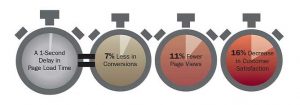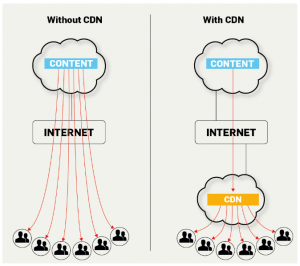Satisfy Your Visitors’ Need for Speed with a Content Delivery Network (CDN)
Web Hosting Blog
Let’s face it. Online visitors are an impatient bunch. And, unfortunately, they crave resource-intensive content, such as video and images. Given that one out of four online customers will abandon a webpage that takes more than four seconds to load, it’s enough to make any SMB’s servers fold under the pressure.
Slow Content is Costly
Long load times are a key cause of high bounce rates. And, since April 2010, load times are a factor in Google’s ranking algorithms. But, the ultimate price of slow content is low conversions. Just how much is your sluggish content delivery damaging your results? This image puts it in perspective.

Studies from Yahoo, Google and others have shown as much as a 10% drop in conversions per each additional second of page load time. Ouch.
Location, Location, Location
The efficiency of your content delivery has a direct impact on visitor engagement, brand perception and revenue. The problem is, you now have more types of content to manage—dynamic, static and streamlining—and in today’s global market, your visitors could be anywhere. Say you’re trying to serve up all your content from one location, Dallas, Texas. It’ll take a hot prospect in Australia a lot longer to download a video than it would someone in Denver. When it comes to optimizing your user experience, and your results, location matters.
Content Delivery Networks (CDN) to the Rescue
Content Delivery Networks, or CDNs, have emerged as an ideal solution to keep up with the insatiable demand today’s visitors have for online video, streaming media and more. So, what are they and how do they transform both experience and conversion?
What is a CDN?
A CDN is a globally distributed network of web servers that enable faster delivery of content and increased availability. Each node, also called an Edge Server, caches your content, so it exists in many places across the world. When a visitor requests content, the closest node delivers it, ensuring the shortest distance and fastest experience. This process is completely seamless to the visitor. CDNs allows even small companies appear larger while ensuring secure, responsive and reliable connectivity to their customer base.

One Network, Many Business Advantages
The number one reason companies implement a CDN is to improve user experience, but there’s a lot more benefits where that came from.
Increased Conversions—For every one second of web performance improvement, WalMart gained a 2% increase in conversions. Shopzilla saw more than a 12% revenue increase from speeding up average page load times from 6 to 1.2 seconds.
Significant Cost Savings—Easing the demand on your IT infrastructure means fewer servers, lower power and cooling costs, load balancing and better resource utilization. These improvements translate into lower capital and operating costs.
DDoS Protection—Not only does having a large distributed server network get your visitors to where they’re going faster, CDNs prevent server overload. They take on, and distribute, the traffic and keep your website up and running.
What to Look for in a CDN
All CDN providers deliver static, dynamic and streaming content more efficiently. But they can also differ in some key areas.
Here are four important considerations you should evaluate when comparing CDN options:
Functionality—Many CDN solutions offer additional features, such as real-time usage statistics, or advanced security-related services, such as a Web Application Firewall (WAF).
Performance—Speed matters, so look at both the latency in ms, the throughput in kbit/s, and the power of the servers themselves.
Service—You never know when you’ll need support, so ask about the knowledge level and typical speed of resolution.
Geography—Find out where their Points of Presence (PoP) are located to ensure they align with your target audience.
CWCS’s cWatch Web is an affordable, fully managed all-in-one security solution that includes a CDN as part of its multi-stack protection. Find out how it helps you improve your user experience, conversions and much more.

